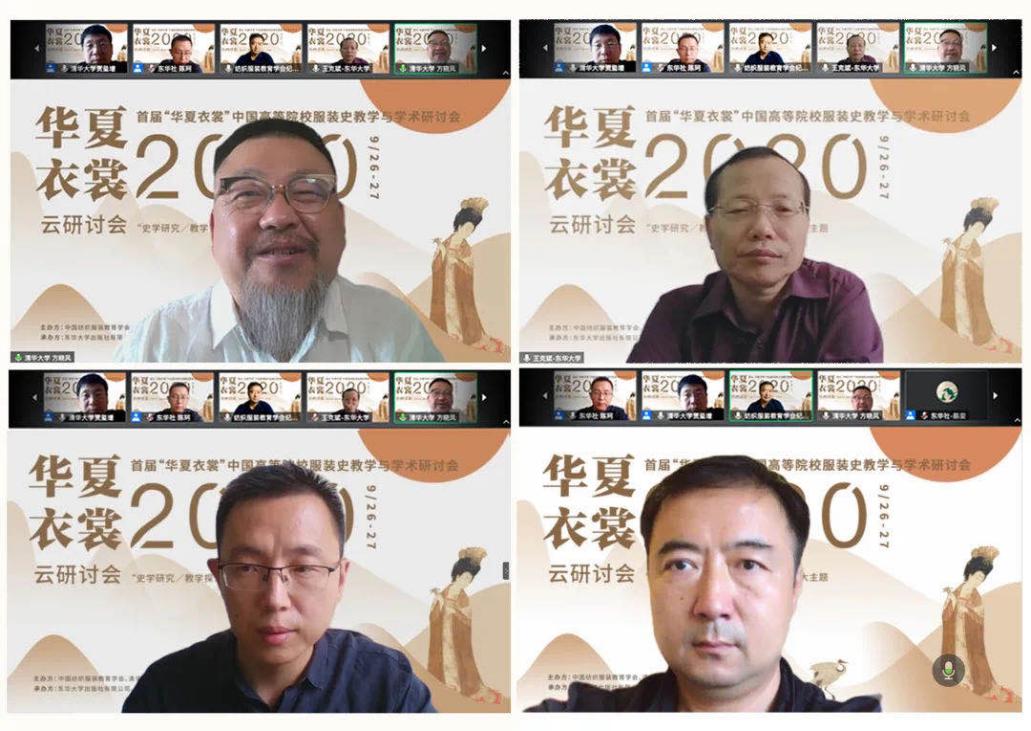From September 26th to 27th, the 1st “Huaxia Costume” - Clothing History Teaching and Research Academic Seminar of Chinese Colleges and Universities was held, sponsored by the China Textile and Apparel Education Society and the Academy of Arts & Design, Tsinghua University, undertaken by Donghua University Press Co., Ltd., and the Journal Center of Donghua University, and co-organized by 74 colleges and universities in China. This seminar was conducted online by Tencent Meeting and was broadcast live through the official Bilibili account of Donghua University Press. A total of 31 well-known experts attended the seminar and exchanged views on topics of “historical research, teaching discussion, and innovative design”.
Fang Xiaofeng, vice dean of the Academy of Arts & Design, Tsinghua University, Wang Kebin, director of the Journal Center of Donghua University, Chen Ke, vice president (director) of Donghua University Press, and Ji Xiaofeng, vice president of the China Textile and Apparel Education Society, delivered speeches at the opening ceremony. Fang Xiaofeng said that for higher education, teaching should be the most important foundation. As time changes, it would bring a higher and newer demand to use teaching modes. It should be very necessary to hold the teaching seminar which has a wide practical significance. And he hoped the construction of specialized design courses could rise to a new level. Chen Ke and Wang Kebin believed that the current teaching and academic research on clothing history could be of important significance, everyone should try their best to spread the results of this seminar in a better manner. Ji Xiaofeng said that clothing history is a compulsory course for students majoring in clothing which plays an important role in training relevant professionals. He hoped that this event could build a platform for teachers and students to communicate and learn.

(Site of the online seminar)
In the discussion session themed on historical research, Professor Zang Yingchun of Tsinghua University discussed the representations and deep aesthetics of eastern and western clothing culture based on the comparison of the culture of modern Chinese and French women’s clothing. Associate Professor Li Meng of DHU explained the relationship between the Book of Carriages and Dressings and the research of the history of ancient Chinese dyeing and weaving clothing, and also discussed how to use the book to study the specific form, development and evolution, manifestation pattern, classification of clothes with cap. Professor Choe Yeon Woo of Dankook University in South Korea shared a special course of the university which would use real clothing for teaching through cooperation by the Department of Traditional Clothes of Dankook University and researchers from the Institute of Clothing Research affiliated to the University Museum. Professor Zhang Ling of Communication University of China took the quantitative research on the clothing form as a starting point, and then evaluated the female clothing fashion of the Song Dynasty based on the real women’s clothing of the Southern Song Dynasty excavated by archaeologists, combined with images and documentary evidence.
In the discussion session themed on teaching discussion, Associate Professor Jia Xizeng of Tsinghua University, based on his teaching experience, explained how to construct a knowledge research system of traditional Chinese clothing culture from three aspects of clothing history, pattern history, and fashion, and how to integrate these three elements to enhance innovation design level. Meanwhile, he explained the knowledge construction and textbook compilation of the Chinese clothing history curriculum by sharing teaching practice cases, and explored the writing characteristics of the Chinese and foreign clothing history, the Chinese clothing history and the concise version of the clothing history in the textbook series of the theory on clothing history, whereby the process of integrating scientific research and teaching in the process of knowledge construction and textbook compilation of the Chinese clothing history curriculum was demonstrated.
From the perspective of innovative design, Professor Lu Min of Tsinghua University explained the basic concepts of new Chinese design, and analyzed how the modern design methods and materials and craftsmanship could be used to interpret the essence of traditional Chinese culture under the traditional aesthetic paradigm. Professor Cui Rongrong of Jiangnan University sorted the concept of traditional clothing patterns to explore its hidden cultural, religious and social connotation, and discussed the use of traditional clothing patterns in clothing design, which could be of great value to modern design. Professor Tao Yin of China Academy of Art introduced the teaching philosophy of oriental design system of the Clothing Dyeing and Weaving Design Major of China Academy of Art, and shared the teaching characteristics of realizing the integration between traditional culture and contemporary social innovation.
At the end of the Seminar, Zhou Dehong expressed gratitude to the participants, and hoped that exchanges would be strengthened and the Donghua University Press would develop an environment for promoting cooperation. This seminar had attracted much attention, and on that day of the opening ceremony more than 100,000 people watched the live broadcast through the official Bilibili account of Donghua University Press.


